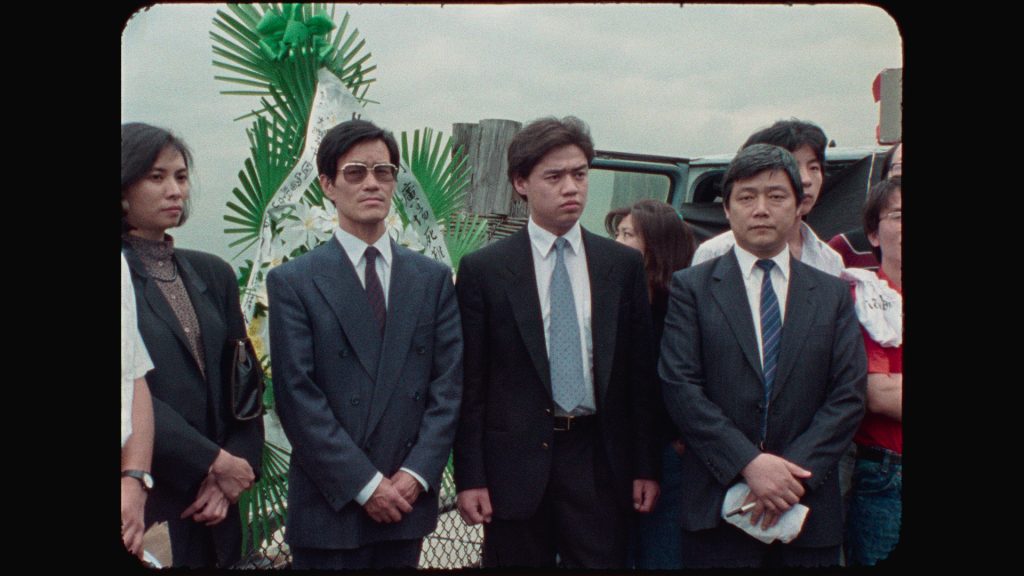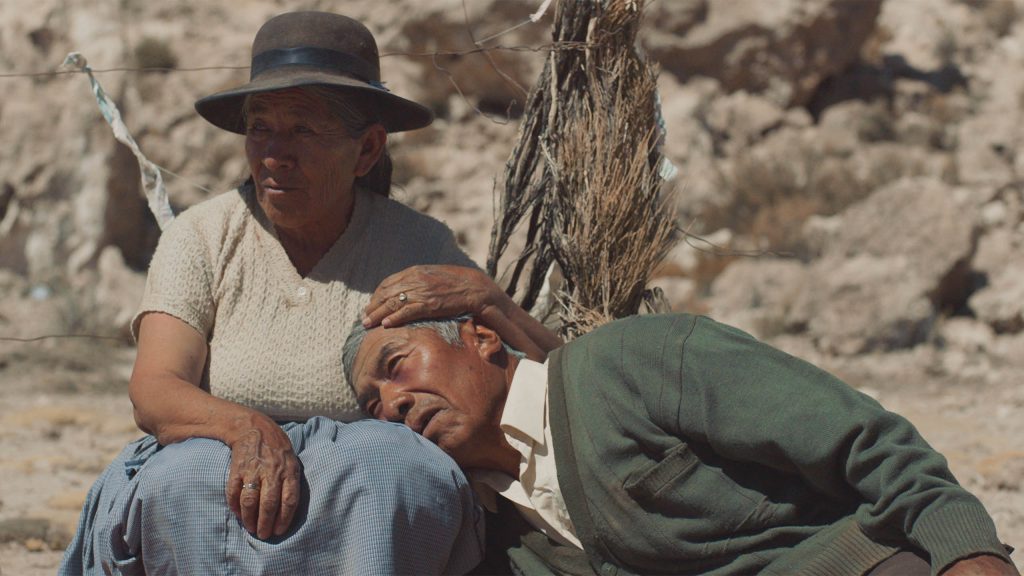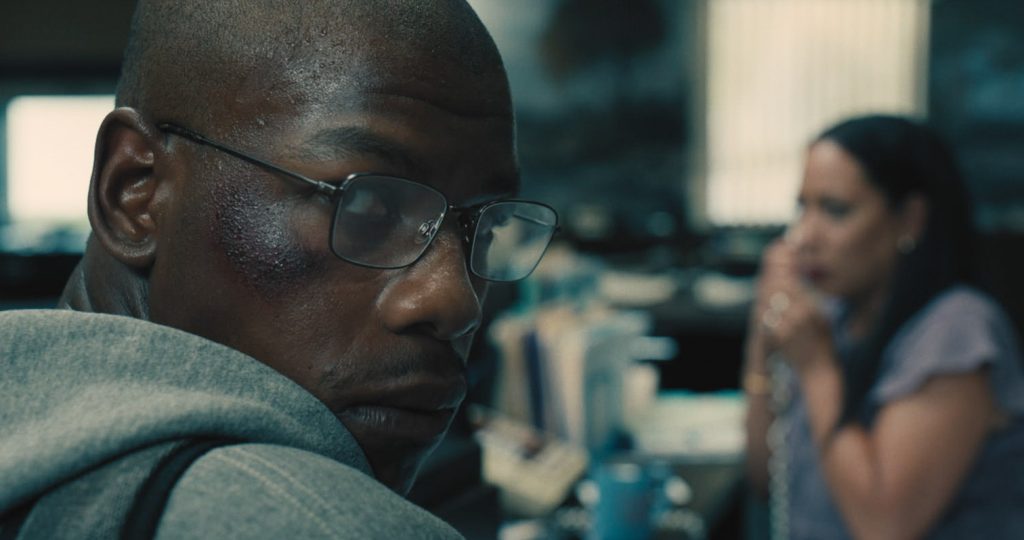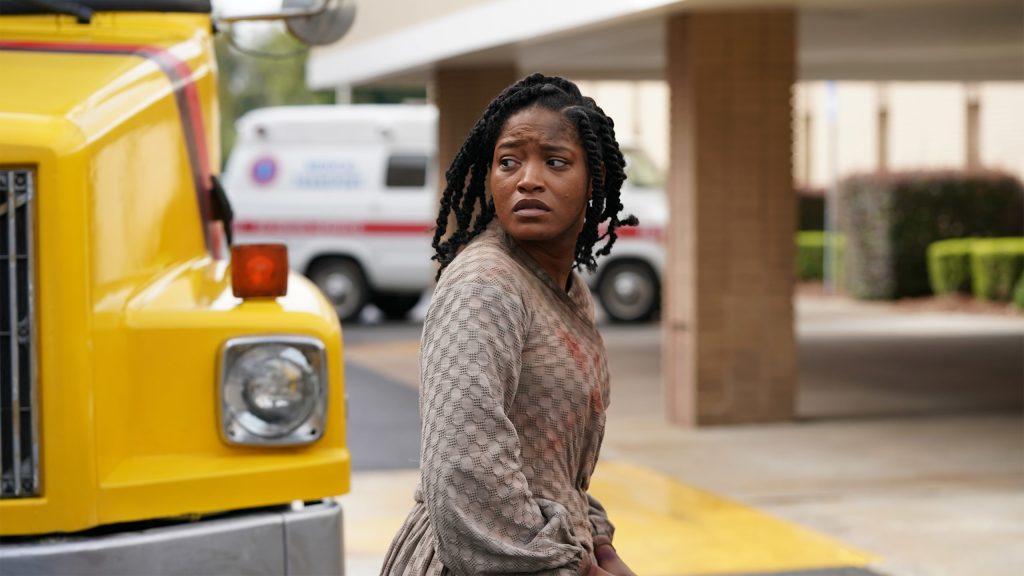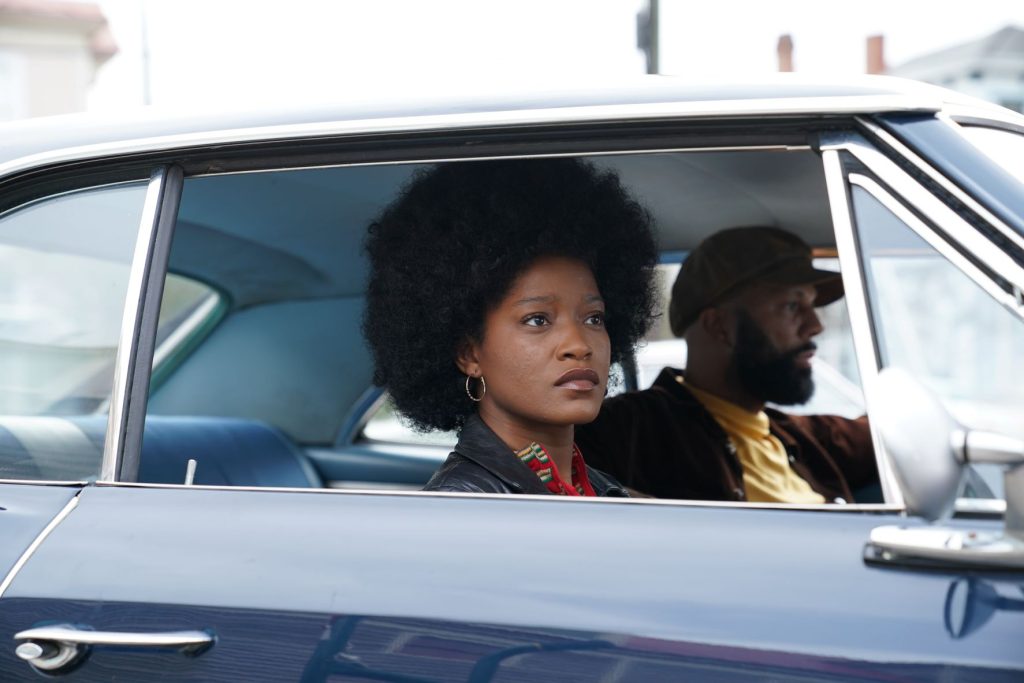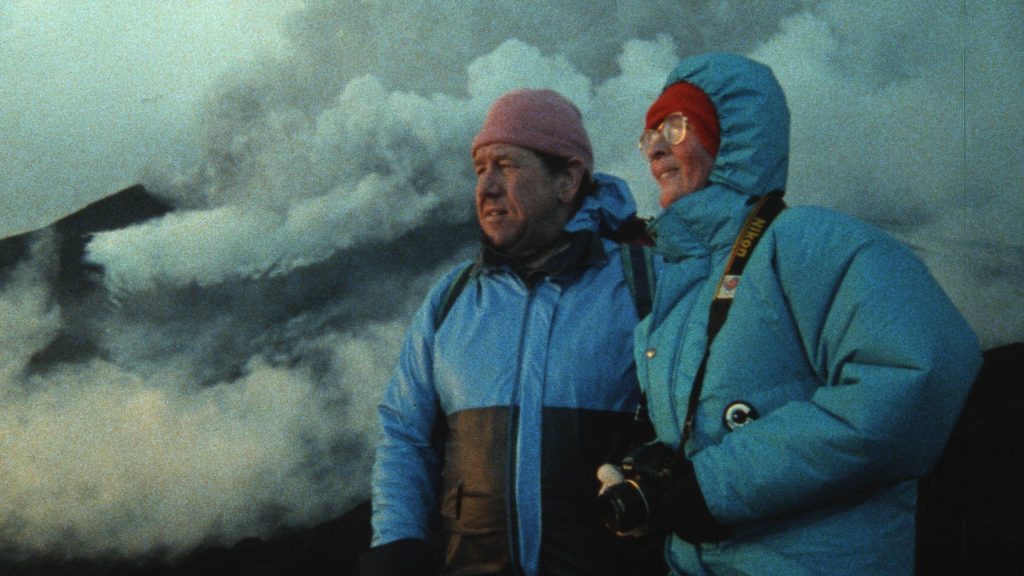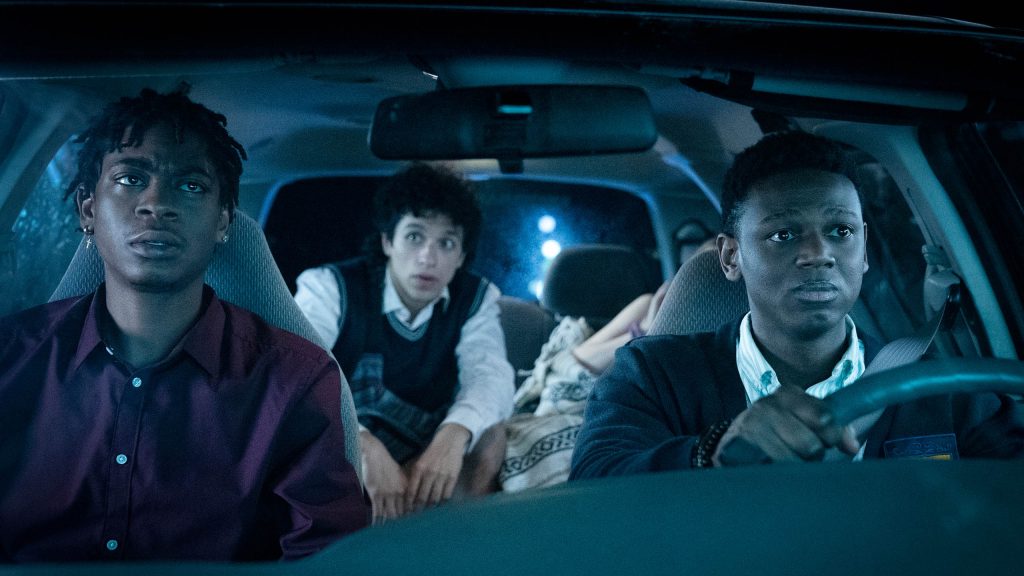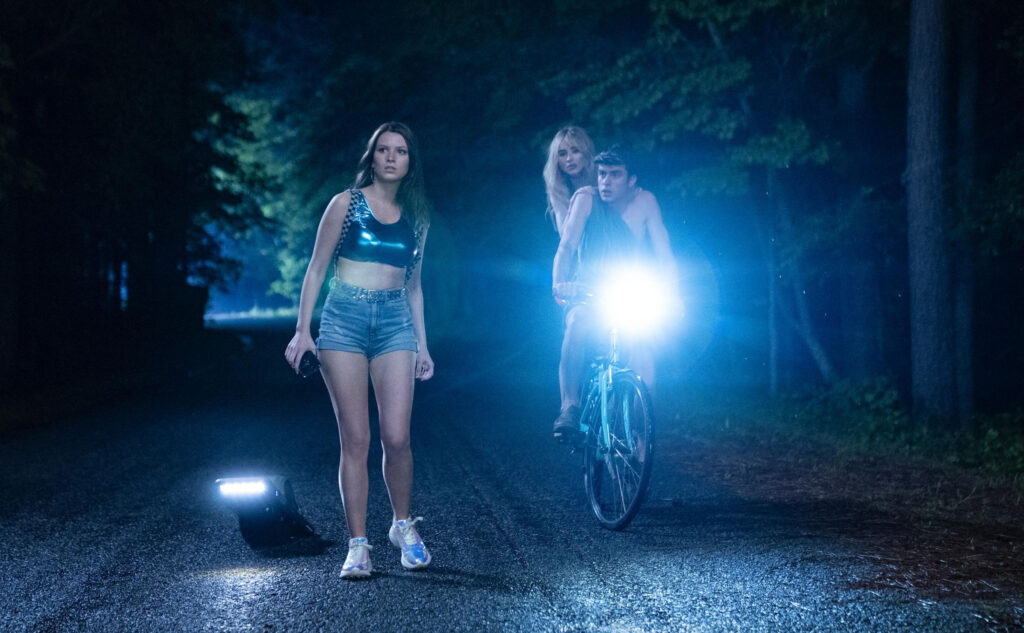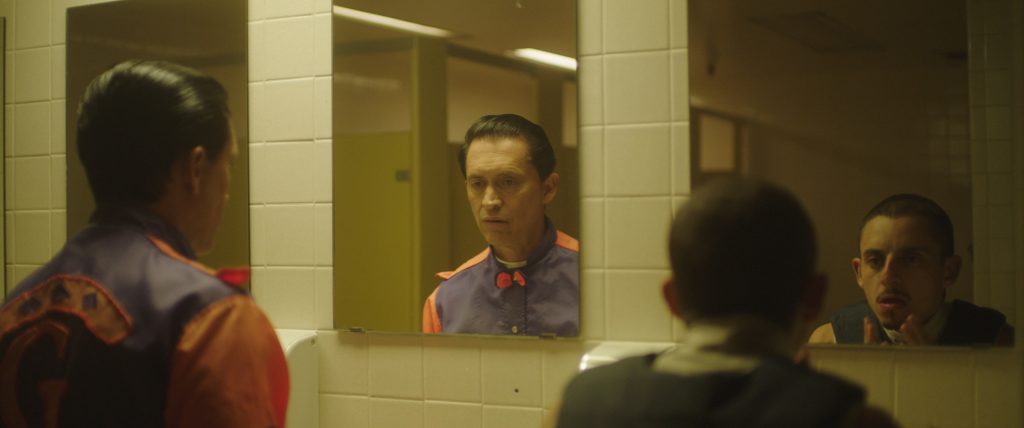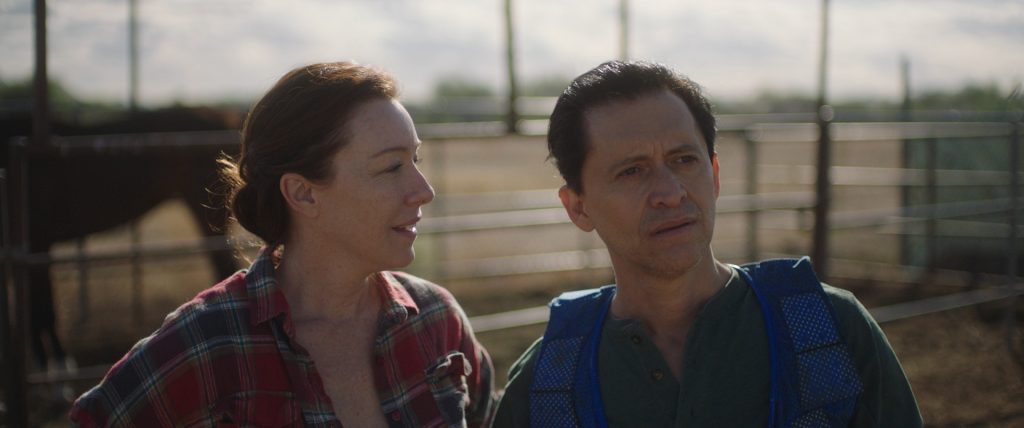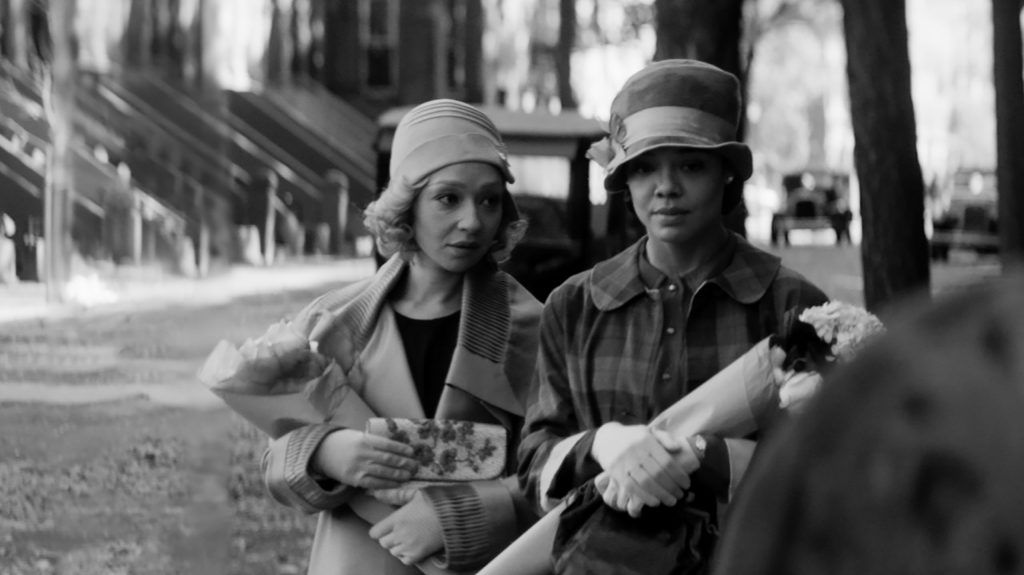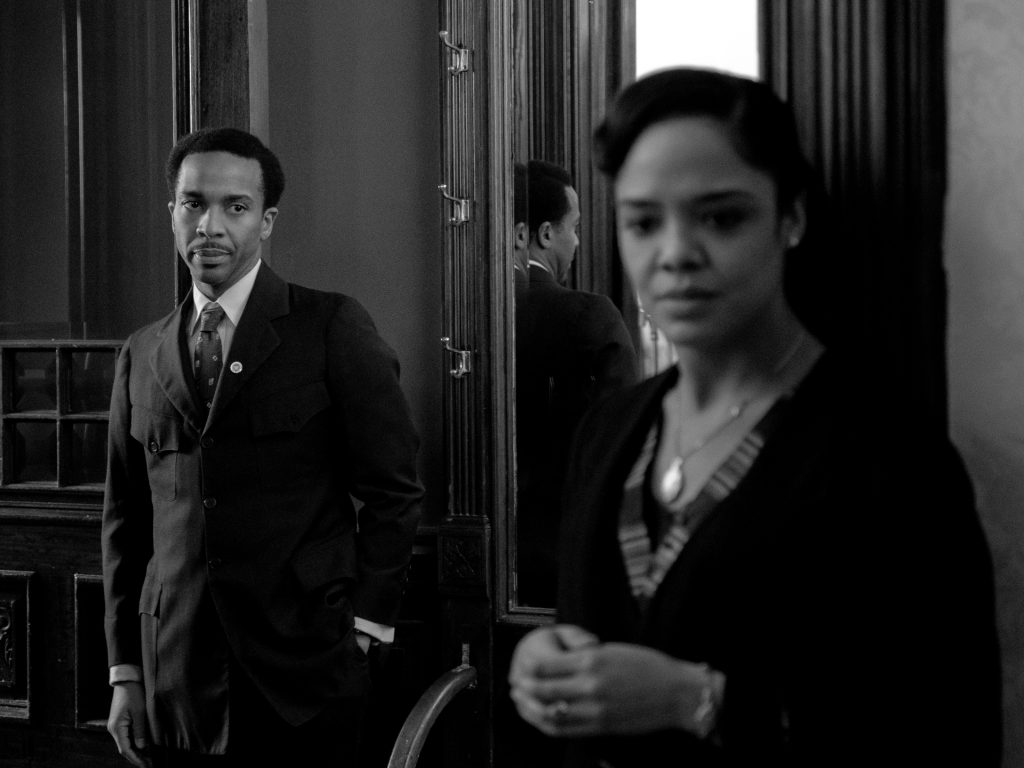January 29, 2022
by Carla Hay

Directed by Nikyatu Jusu
Some language in French and Wolof with subtitles
Culture Representation: Taking place in New York City, the horror film “Nanny” features a cast of white and black characters (with a few Latinos and Asians) representing the middle-class and working-class.
Culture Clash: An undocumented Senegalese immigrant, who works as a nanny for an upper-middle-class white family in New York City, has nightmarish visions, as she anxiously waits for the arrival of her 6-year-old son from Senegal.
Culture Audience: “Nanny” will appeal mainly to people who are interested in watching movies that draw parallels between mythical horror and the psychological horror of being an underprivileged immigrant who’s experiencing family separation.
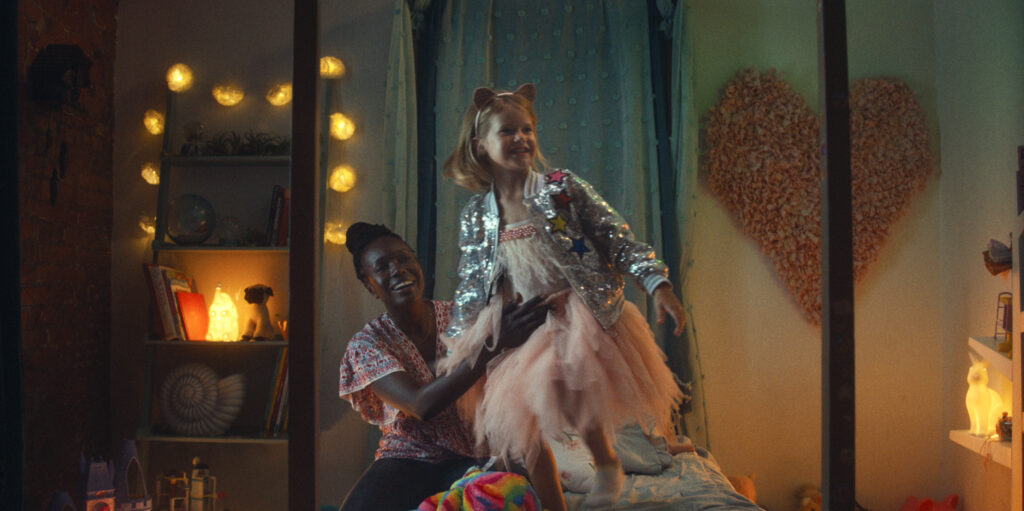
“Nanny” uses horror-movie techniques that don’t always work as well as they should, but this haunting story nevertheless effectively shows the anguish and terror of being a vulnerable, undocumented immigrant who’s separated from family. It’s yet another horror film where the protagonist (usually a woman) keeps seeing strange, nightmarish visions. And the movie eventually reveals what those visions are about and who will survive in this ordeal. “Nanny” had its world premiere at the 2022 Sundance Film Festival, where it won the U.S. Dramatic Competition’s Grand Jury Award, which is the festival’s top prize.
In “Nanny” (written and directed by Nikyatu Jusu), the story centers on an undocumented immigrant from Senegal who lives and works in New York City as a nanny. Her name is Aisha (played by Anna Diop), and the main thing that’s on her mind is her planned upcoming reunion with her 6-year-old son Lamine (played by Jahleel Kamara), who lives in Senegal. Aisha is a single mother, so Lamine is in the care of her cousin Mariatou (played by Olamide Candide-Johnson), who keeps in touch with regular phone calls that include video chats with Lamine. Mariatou and Aisha have such a close relationship, they refer to each other as “sister.”
Aisha has been saving enough money to bring Lamine to live with her in the United States. Lamine will be an undocumented immigrant too, but Aisha thinks it’s worth the risk so that they can be reunited with each other. In a conversation that Aisha has with a confidante named Sallay (played by Zephani Idoko), a Nigerian hairdresser who also lives in New York City, viewers find out that Lamine’s biological father is married, and these spouses know about Lamine. It’s implied that Lamine was born out of an extramarital affair.
Aisha had a falling out with Lamine’s father, so she no longer speaks to him. When Sallay suggests that Aisha get financial help from Lamine’s father, by apologizing to him and his wife, Aisha makes this comment that essentially sums up what went wrong: “Apologize?” Aisha says with annoyance. “It is him who should apologize when he impregnates every teen girl on the way to school … He doesn’t care if his own son lives or dies … He cut me off when I was pregnant.”
Before she moved to the U.S., Aisha was a schoolteacher who taught English and French in Senegal. (She mentions it in a conversation. The movie doesn’t have flashbacks.) In other words, Aisha is educated enough to get a higher-paying job than being a nanny. But as an undocumented immigrant in the U.S., her employment options are limited.
In the beginning of the movie, Aisha is seen getting a new job working as a nanny for an upper-middle-class family living in a sleek apartment. The family matriarch who hires Aisha is Amy Harold (played by Michelle Monaghan), a busy corporate executive, who at first seems pleasant and accommodating. Amy’s husband Adam Harold (played by Morgan Spector) is a photojournalist who frequently travels for his job. Amy and Adam have a 5-year-old daughter named Rose (played by Rose Decker), who is a curious and friendly child.
Aisha doesn’t live with the Harold family, but Amy shows Aisha the bedroom where Aisha can stay during the occasions when Aisha might have to do overnight work. As stresses pile on in Aisha’s life, she starts to have nightmares and strange visions, often in this guest bedroom. At first, it might seem that “Nanny” is a haunted house movie, but Aisha starts having nightmares in her own home and starts having hallucinations during the day at various places.
Working overnight in the Harold household involves an extra fee, which Amy and Aisha agreed would be $150. Even though Amy smiles and hugs Aisha on Aisha’s first day on the job, there are some red flags that Amy is a control freak who tests Aisha in how much Amy can get away with in taking advantage of Aisha. One of those red flags is that Amy tries to lowball the amount for the overnight fee until she sees that Aisha didn’t forget the agreed-upon amount and won’t lower the fee.
Amy gives Aisha a journal-sized book of instructions on how to take care of Rose. The journal also has blank pages, where Aisha is expected to keep meticulous entries of what Rose was doing while in Aisha’s care. That might be a fair-enough demand from an overprotective parent. Another reasonable demand is that Aisha cannot burn incense or candles in the home, because Amy says that Rose is “sensitive to smells.”
But Amy is extremely controlling about what Rose can and cannot eat. And it’s not because Rose is on a strict, medical-based diet. Amy will not allow Rose to eat any food that’s considered “exotic” or “spicy.” Rose is expected to eat only bland food that’s considered American or European cuisine. You know what this diet restriction implies, of course.
It doesn’t take long for Aisha to break this rule, when she cooks some African dishes for herself, such as jollof rice, and Rose insists on eating it too. Rose likes eating African food so much that Aisha secretly gives Rose some of this food to eat when Amy isn’t there. Rose and Aisha have a very good rapport with each other. In many ways, because Aisha isn’t as controlling and moody as Amy, Rose seems to like Aisha more than Rose likes her own mother.
Over time, Amy becomes a much more difficult and unpleasant employer. She makes last-minute demands for Aisha to stay overnight, without much regard for the possibility that Aisha could have other plans that she wouldn’t be able to change on such short notice. Amy also expects Aisha to listen to Amy’s complaints about Amy’s job, even though it isn’t part of Aisha’s job description to be a counselor for Amy.
Even worse, Amy stops paying Aisha, with vague excuses that it’s not a good time to pay her, and that Aisha just has to be patient to get the money that Aisha is owed. When Aisha asks Adam to help with this problem, he agrees to help on one occasion when he gives Aisha some cash as a partial payment. But then, Adam passes the responsibility completely back to Amy, who makes veiled threats to Aisha that she can have Aisha deported if Aisha complains about not getting paid.
These are all tactics used by unscrupulous employers who take advantage of undocumented workers, because they know the workers don’t want to be deported. Ironically, in a conversation that Aisha has with Sallay fairly early on in the movie, Sallay comments, “I’d rather be a slave in America than a slave in Africa. At least here, when you work, you see the money.” “Nanny” shows how easily it is for undocumented workers to become modern-day slaves when employers refuse to pay for employees’ work.
It might be easy for some viewers to wonder why Aisha didn’t just quit and find a job somewhere else. But the type of domestic work she would be looking for relies almost entirely on personal referrals. (She can’t go to an employment agency, for obvious reasons.) Someone in Aisha’s situation would be terrified of being “blackballed” or labeled a “troublemaker” by the usually insular community of well-to-do people in New York City who hire undocumented workers to be their domestic employees.
In addition, Aisha has some sexual harassment to deal in this job. It’s telegraphed as soon as Adam is first seen in the movie. When he arrives home from a business trip, he coldly and rudely reacts to Amy as she greets him warmly with a hug and a kiss. Adam soon finds out that he has come home to a surprise birthday party that Amy has arranged. He immediately puts on his “happy husband” face to the party guests, but the tension in this marriage is noticeable to anyone who saw how dismissively Adam was acting toward Amy when he walked in the door.
Aisha notices it, but she avoids getting in the middle of Amy and Adam’s marital problems. It’s perhaps unavoidable that at some point, Aisha and Adam are alone together. On one of those occasions, Adam shows her a photo portrait on display in the home that he says is probably one of the best photos he’s ever taken. It’s a photo of a young African man during a civil uprising protest. Adam also says that his specialty is taking these types of photos because he cares about social justice. He brags about it, as if it’s supposed to make him look like an open-minded liberal.
Eventually, Aisha makes the mistake of confiding in Adam that she’s anxiously awaiting the arrival of her son Lamine from Senegal. As soon as Adam finds out that Aisha has this emotional vulnerability, it’s not much of a surprise when he makes a sexual advance on her by kissing her fully on the mouth. She reacts with surprise, but makes it clear to Adam that she’s not interested.
Adam makes a profuse apology, and he promises that it won’t happen again. But at this point, it’s obvious to viewers (and Aisha) that Adam can’t really be trusted. Aisha tries to act like Adam’s sexual harassment never happened. After all, Aisha is too afraid to report this sexual harassment because she doesn’t want to expose her undocumented immigrant status. Adam knows it too, which is probably why he felt emboldened to sexually harass her.
Meanwhile, Aisha has caught the attention of a doorman who works in the apartment building. He’s a single father named Malik (played by Sinqua Walls), who flirts with her and is persistent, even when she doesn’t seem interested. Eventually, Malik charms Aisha to go on a date with him.
The icebreaker happens when Malik’s son Bishop (played by Jamier Williams), who’s about 7 or 8 years old, happens to be visiting Malik in the apartment lobby when Aisha is there. Malik introduces Bishop to Aisha. Bishop then blurts out: “My dad has a crush on you!” Aisha likes that Malik seems to be a devoted and loving father, so she agrees to go on a date with him.
Mailk and Aisha eat at a soul-food restaurant on their first date. Before they head to the restaurant, Malik brings her to his grandmother’s place for a brief meeting with his grandmother Kathleen (played by Leslie Uggams), whom he adores and respects. Malik also says that Kathleen is psychic.
During this short visit, Aisha mentions to Kathleen that she’s been having unsettling dreams about a mermaid who’s trying to drown Aisha. Viewers find out later that Aisha’s dreams are related to the African folklore of the mermaid Mami Wata. Aisha tells Kathleen that she’s not superstitious, and she doesn’t believe in magic.
Kathleen replies, “Whether you do or not, you are magic.” Kathleen also asks, “What’s your boy’s name?” A startled Aisha replies, “How did you know?” Before she leaves, Aisha says to Kathleen, “His name is Lamine.”
During their dinner date, Malik and Aisha both talk about their lives and their families. Malik is co-parenting Bishop with Bishop’s mother, who is Malik’s ex-girlfriend. (This ex-girlfriend is not in the movie.) Aisha and Malik find out that they have something else in common besides being parents to young sons: Malik’s and Aisha’s mothers are both deceased. Malik mentions that his mother had schizophrenia.
Things continue to go well in the romance between Malik and Aisha, but her nanny job and her hallucinations become increasingly alarming. She begins to see spiders in her bed. In one scene, a spider crawls into her mouth. It’s a nod to the African horror myth of the spider Anansi.
Aisha really begins to come psychologically unglued when the visions or hallucinations she’s seeing begin happening outside of her sleep at night and occur in her daytime activities. While in a park with some other nannies, she sees Lamine, even though she knows he’s really in Senegal. And when she’s at a public swimming pool with Rose, Aisha sees the mermaid try to drown her again. But then she wakes up on the edge of the pool, with strangers around her telling her that she fainted.
And it gets worse for Aisha. “Nanny” keeps viewers guessing over whether or not Aisha is experiencing sleepwalking, psychotic breaks or something supernatural. There’s a very harrowing point in the movie where it looks like serious harm or death could happen to an innocent person.
Although there’s plenty of tension in “Nanny,” some of the movie’s intended “jump scares” get a little too repetitive. How many times do viewers have to see Aisha seeing something terrifying, only to find out that she was dreaming or unconscious? After a while, the impact of these scares diminishes, and it feels like too many jump scares that don’t further the movie’s story.
However, there’s a big “reveal” in the last third of the movie that explains why Aisha keeps having these frightening visions. The revelation is both tragic and emotionally devastating. Only in hindsight can viewers clearly see some of the clues leading up to to this big revelation.
Diop carries the movie quite well with the wide range of emotions that she has to convey. The character of Aisha is really the only one who comes closest to being a fully developed character in the movie. Writer/director Jusu effectively immerses viewers in Aisha’s interior and exterior life. And many the horror scenes are genuinely creepy, even though the spider scenes look a bit recycled from many other horror movies.
Unfortunately, the supporting characters aren’t very well-developed in this movie. All of the cast members in supporting roles do capable performances, but they are just performing “types” of people: Amy and Adam are the “exploitative boss” type. Rose is the “cute kid” type. Malik is the “nice guy” type. Kathleen is the “mysterious psychic” type.
All of the movie’s immigrant worker characters who are not Aisha don’t have enough screen time to make an impact on the story. The scene in the park has two Caribbean nannies named Cynthia (played by Keturah Hamilton) and Florence (played by Mitzie Pratt), who have a very realistic and sometimes hilarious conversation, but this brief scene is all that the movie has for these lively characters. Aisha’s friendship with Sallay is also quickly introduced and then ignored for the rest of the movie.
If “Nanny” wanted to make a statement about the culture and conditions under which immigrant nannies work in New York City, then Aisha is the only significant perspective that’s presented, to put an emphasis on her isolation. In that regard, the romance story with Malik seems a little extraneous and tacked on as a reason for Aisha to come in contact with Malik’s psychic grandmother. At one point in the movie, when Aisha starts to believe that maybe something supernatural is happening, she seeks out advice from Kathleen.
“Nanny” can be commended for putting the spotlight on the reality that many nannies in America are undocumented non-white immigrants, even though movies made in America usually depict nannies in America as white women who are U.S. citizens. “Nanny” is more of a psychological portrait than a general overview of the exploitation that can often occur in this line of work. It’s a movie that’s bound to make some people uncomfortable, but acknowledging that race, ethnicity and citizenship play big roles in how workers are treated is at least the first step in dealing with this discrimination problem.
UPDATE: Amazon Studios will release “Nanny” in select U.S. cinemas on November 23, 2022. Prime Video will premiere “Nanny” on December 16, 2022.


